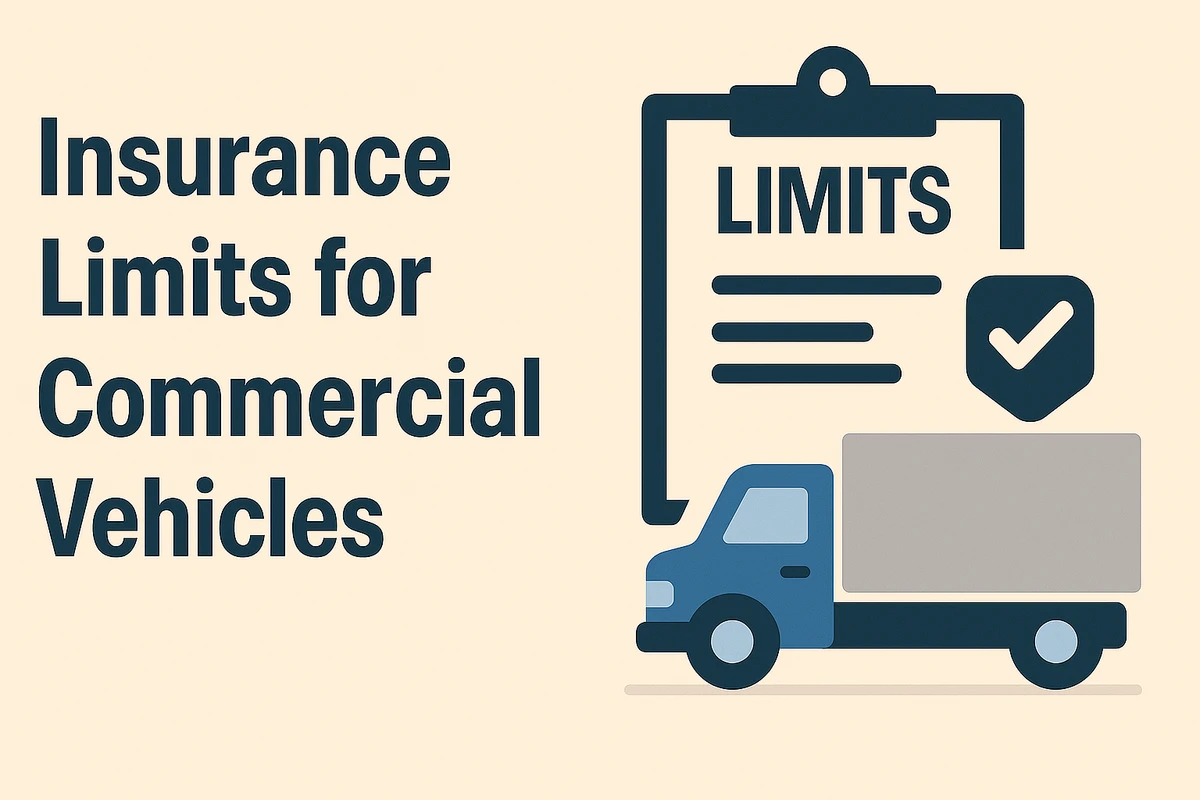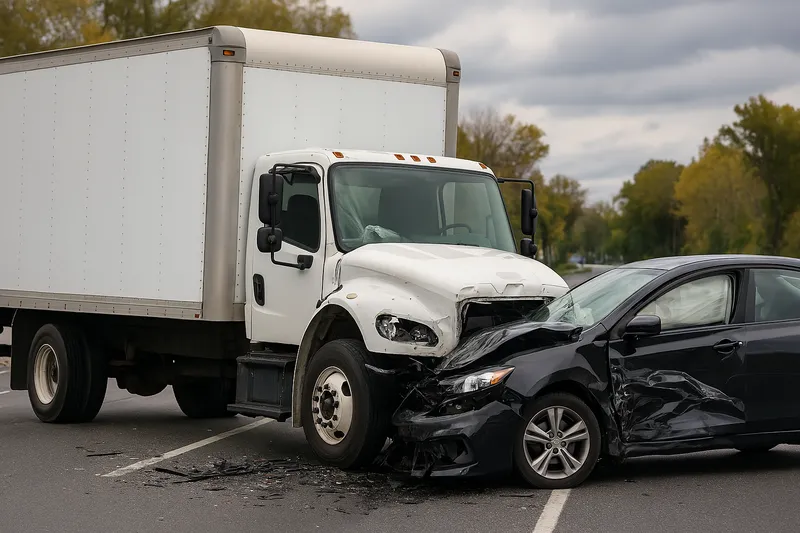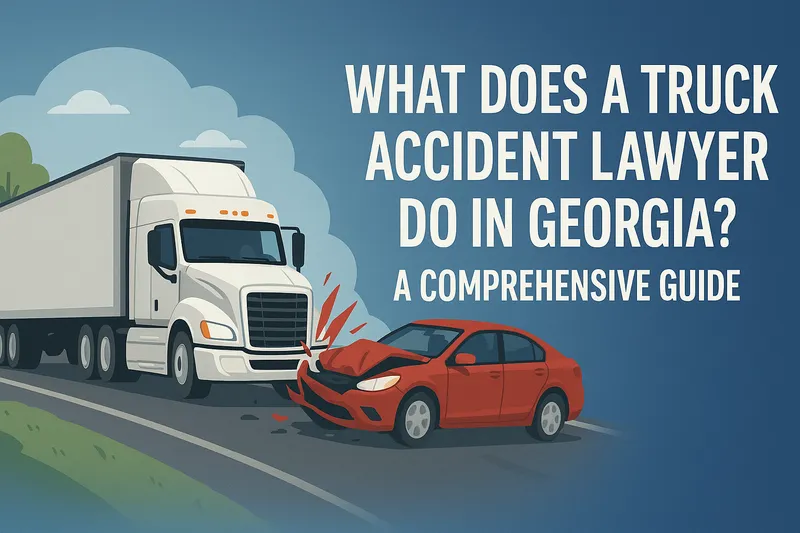Insurance Limits in Commercial Truck Accidents in Georgia

Published: 4/4/2025
This guide will explain exactly what a truck accident lawyer does at each stage of a case and how Georgia-specific laws (like fault rules and filing deadlines) can affect truck accident claims.
Why Insurance Requirements Matter in Commercial Truck Accidents in Georgia
Commercial truck accidents often cause devastating injuries and damages. For Georgia injury victims, one critical factor in these cases is insurance coverage. Both Georgia law and federal regulations mandate minimum insurance for trucks, but the required limits vary by vehicle type and operation. Understanding these insurance requirements – and why they matter – can help accident victims know what compensation may be available after a crash. In this article, we break down insurance rules for different types of commercial vehicles (from 18-wheelers to delivery vans), explain how insurance limits affect injury claims, discuss common issues with insurance companies, and offer guidance on protecting your rights.
Understanding Insurance Requirements in Georgia Truck Accidents
State vs. Federal Insurance Laws: In Georgia, trucks operating intrastate (only within state lines) are subject to Georgia’s insurance laws, while interstate trucks (crossing state lines) must comply with federal regulations. Georgia has adopted many federal rules, but the minimum liability coverage required can differ. Generally, larger and heavier vehicles or those carrying hazardous cargo must carry higher insurance limits to ensure funds are available for victims if a serious accident occurs.
Georgia’s Minimum Coverage:
For many commercial vehicles, Georgia’s required insurance minimums are surprisingly low – often the same as for private passenger cars (as little as $25,000 per person/$50,000 per accident) for smaller vehicles. However, Georgia law increases the minimum for heavier trucks (over 10,000 lbs) operating intrastate to $100,000 per person and $300,000 per accident in bodily injury liability coverage. These higher limits reflect the greater harm large trucks can inflict.
Federal Requirements:
The Federal Motor Carrier Safety Administration (FMCSA) sets higher minimum insurance limits for trucks in interstate commerce. Most interstate freight carriers operating large trucks (gross vehicle weight 10,001 lbs or more) must have at least $750,000 in liability coverage. The required minimum jumps even higher for those hauling hazardous materials – typically $1,000,000 for certain hazardous cargo (like oil or specific dangerous materials) and up to $5,000,000 for the most dangerous substances or large-capacity hazardous cargo. Even some lighter commercial vehicles involved in interstate commerce have a federal minimum of $300,000 in coverage. These federal mandates aim to protect the public by ensuring substantial coverage is in place for catastrophic accidents.
Why Do These Limits Matter?
Insurance limits determine the maximum compensation readily available from an insurer after a crash. Commercial trucks can cause life-altering injuries, from severe spinal injuries to wrongful death, leading to damages that easily exceed standard auto policy limits. Higher required coverage means victims have a better chance to be fully compensated. For example, an 80,000-pound semi-truck at highway speed can cause catastrophic damage, so a $750,000 (or higher) policy is intended to cover those extensive losses. On the other hand, if a truck only carries the minimum and your losses exceed those limits, it complicates recovery – you might be left underinsured or forced to pursue the trucking company’s assets or other parties for the rest. In essence, the insurance requirement sets a floor for potential recovery in an accident case. It’s worth noting that these legal minimums are just minimums – many trucking companies carry much more insurance (often $1–$5 million) to protect themselves given the severity of truck crashes. But not all do, especially smaller operators, so the mandated limits may be all that’s available unless additional policies (like umbrella insurance) exist.
The high insurance limits for big rigs matter because accidents involving 18-wheelers are often catastrophic. A fully loaded tractor-trailer can demolish multiple vehicles; injuries to occupants of passenger cars can be severe or fatal. The costs – medical bills, lost income, long-term care, pain and suffering – often run into the hundreds of thousands or millions of dollars. The required $750k (or higher) policy provides a fund to cover these losses. However, even $750,000 may be inadequate for a truly catastrophic injury or multiple victims. Victims in Georgia truck accidents involving semis should be aware that while there is likely a substantial insurance policy available, it might still fall short of covering all damages in a worst-case scenario. That’s why an experienced attorney will often investigate whether the trucking company carries excess or umbrella insurance beyond the minimum. Many large trucking companies do have umbrella policies or multiple layers of insurance, which can be tapped if the primary policy isn’t enough. In short, the insurance requirement for 18-wheelers is a crucial safety net – it means there’s likely significant money available for your claim, but it also sets the stage for how much you can realistically recover from the insurer(s).
Insurance impact on injury claims: With semi-trucks, dealing with insurance is both a blessing and a challenge. On one hand, the higher policy limit means there’s a better chance to cover all your losses. On the other hand, because a lot of money is at stake, the trucking company’s insurer will vigorously defend the claim. Major trucking insurers have specialized adjusters and legal teams who handle truck accident claims daily. They may dispute liability or the extent of damages aggressively to avoid paying the full value. It’s common for trucking companies to have a “rapid response” team – representatives (sometimes even attorneys or accident reconstruction experts) who go to the crash scene immediately to gather evidence in the company’s favor. In a claim against an 18-wheeler, you may be dealing with multiple insurance policies . This complexity means injury victims need to be especially careful and ideally get legal help to navigate the insurance process. The bottom line: high insurance limits on 18-wheelers are there to protect victims, but securing full compensation from those policies often requires a strong case and advocacy.
18-Wheelers and Semi-Trucks: High Stakes and High Insurance
What they are: 18-wheelers (semi-trucks or tractor-trailers) are the largest common commercial vehicles on Georgia roads. They typically haul freight long distances, often crossing state lines. These trucks weigh many tons and can cause devastating accidents, which is why the law imposes substantial insurance requirements on their owners and operators.
Semi-trucks fall under the highest insurance brackets due to their size and operation:
-
Federal (Interstate): If the semi-truck operates in interstate commerce, it must carry at least $750,000 in liability insurance for non-hazardous cargo. This minimum applies per crash (covering all victims’ claims from one accident). In practice, many interstate trucking companies carry $1 million or more in coverage for their 18-wheelers. If the truck hauls hazardous materials, federal law requires $1 million to $5 million in coverage (depending on the material).
-
Georgia (Intrastate): If a semi-truck operates only within Georgia, state law requires a lower minimum: $100,000 per person and $300,000 per accident for bodily injury liability. This intrastate minimum is considerably less than the federal requirement. However, many in-state trucking companies still opt for higher coverage, and Georgia has adopted most federal safety regulations for consistency. In any event, virtually all 18-wheelers on the road will have some liability insurance – it’s required by law and by the trucking industry’s realities (an 18-wheeler without insurance cannot legally operate and no reputable company would risk running a semi without coverage).
The high insurance limits for big rigs matter because accidents involving 18-wheelers are often catastrophic. A fully loaded tractor-trailer can demolish multiple vehicles; injuries to occupants of passenger cars can be severe or fatal. The costs – medical bills, lost income, long-term care, pain and suffering – often run into the hundreds of thousands or millions of dollars. The required $750k (or higher) policy provides a fund to cover these losses. However, even $750,000 may be inadequate for a truly catastrophic injury or multiple victims Victims in Georgia truck accidents involving semis should be aware that while there is likely a substantial insurance policy available, it might still fall short of covering all damages in a worst-case scenario. That’s why an experienced attorney will often investigate whether the trucking company carries excess or umbrella insurance beyond the minimum. Many large trucking companies do have umbrella policies or multiple layers of insurance, which can be tapped if the primary policy isn’t enough. In short, the insurance requirement for 18-wheelers is a crucial safety net – it means there’s likely significant money available for your claim, but it also sets the stage for how much you can realistically recover from the insurer(s).
With semi-trucks, dealing with insurance is both a blessing and a challenge. On one hand, the higher policy limit means there’s a better chance to cover all your losses. On the other hand, because a lot of money is at stake, the trucking company’s insurer will vigorously defend the claim. Major trucking insurers have specialized adjusters and legal teams who handle truck accident claims daily. They may dispute liability or the extent of damages aggressively to avoid paying the full value. It’s common for trucking companies to have a “rapid response” team – representatives (sometimes even attorneys or accident reconstruction experts) who go to the crash scene immediately to gather evidence in the company’s favor.
In a claim against an 18-wheeler, you may be dealing with multiple insurance policies (for the driver, the trucking company, and even the trailer or cargo owner). This complexity means injury victims need to be especially careful and ideally get legal help to navigate the insurance process. The bottom line: high insurance limits on 18-wheelers are there to protect victims, but securing full compensation from those policies often requires a strong case and advocacy.
Box Trucks: Medium Trucks with Varied Coverage
What they are: “Box trucks” are medium-sized commercial trucks with an enclosed cargo area (the “box”) attached to a cab. They’re commonly used for local deliveries, moving furniture, appliance deliveries, or as rental moving trucks (like U-Haul or Penske trucks). In Georgia, you’ll see box trucks on city streets and highways delivering goods to businesses or homes. They are smaller than semis but larger than the average pickup or van, often ranging from 10 to 26 feet in length.
Minimum Insurance Requirements: The insurance requirements for box trucks can vary widely because this category spans different sizes and uses:
-
Weight Factor: A key factor is the truck’s weight (GVWR). If a box truck’s weight rating is over 10,000 lbs, it generally falls under commercial truck insurance rules similar to larger trucks. In Georgia intrastate operation, that means it should carry at least $100,000/$300,000 in liability coverage. If it’s used in interstate commerce, federal law would require $750,000 minimum . Many box trucks (like 24-26 foot moving trucks) do exceed 10,000 lbs GVWR, so they would need these higher limits by law.
-
Smaller Box Trucks: Some box trucks or large vans might have a GVWR under 10,000 lbs. For example, a small 10-foot delivery box truck or certain cutaway vans might fall just under the threshold. If so, the legal insurance requirement could be much lower if operating only in Georgia – potentially just the normal 25/50k minimum like any private vehicle. However, if that lighter truck is operated by a business, many will carry a commercial auto policy with higher limits for prudence. Federally, for interstate carriers of non-hazardous property under 10,001 lbs, the minimum is $300,000 coverage – so even lighter box trucks engaged in interstate deliveries are expected to carry at least $300k in liability insurance.
-
Business Use: If the box truck is owned by a company (delivery service, moving company, etc.), the company may choose higher coverage limits to protect itself. It’s not uncommon for commercial policies on these medium trucks to be $500,000 or $1 million, especially for companies with fleets, even though the law might only require $300k or $750k depending on circumstances.
Box truck accidents can cause serious injuries – they’re often heavier than passenger vehicles and can do considerable damage in a crash. The range of possible insurance limits is important for victims to understand. If you’re hit by a larger box truck that meets the >10,000 lbs criteria, you can expect at least $300k–$750k of liability coverage should be available, by law, to cover your injuries . But if you’re hit by a smaller box truck or one operating under the radar of commercial regs, it might legally have only a minimal policy (for example, a small local contractor’s truck might have just $25k/$50k because it wasn’t classified as a heavy commercial vehicle). Knowing the truck’s weight and use helps determine the applicable insurance. For injury victims, if the truck’s insurance limit is on the lower side (say $50k or $100k), that might not fully cover a severe injury accident – you could quickly exhaust those limits with a hospital stay or surgery. In such cases, victims may need to explore other avenues: the trucking company’s assets, other liable parties, or even their own uninsured/underinsured motorist coverage.
Impact on injury claims: With box trucks, one issue is that victims might assume a commercial vehicle always has plenty of insurance, but that’s not guaranteed. If the at-fault box truck only carried the minimum, a victim’s claim could be limited by those lower policy caps. Insurance companies for these trucks may try to settle claims up to the small policy limit quickly, especially if they know the damages far exceed it (they might offer the $50k or $100k right away in exchange for a release, which unfortunately wouldn’t cover all losses in a major injury case). On the flip side, when a box truck is well-insured (say a national company’s delivery truck), the insurer will handle the claim much like a larger trucking case – possibly disputing liability or the extent of injuries to avoid paying the full amount. In all cases, identifying the exact insurance coverage of the box truck is a crucial early step. An attorney can help by sending insurance disclosure requests to find out the policy limits and by investigating whether the truck was operating in compliance with state/federal insurance rules. If a box truck was operating illegally without proper insurance, that can also affect the case (it might open the door to claims directly against the company or owner). For Georgia victims, understanding the truck’s insurance situation informs how you approach your injury claim and what compensation you pursue.
Delivery Vans (Amazon, UPS, FedEx): Corporate Vehicles and Insurance Complexities
What they are: Delivery vans are the vehicles we see every day in our neighborhoods delivering packages – from Amazon Prime vans to UPS and FedEx trucks, as well as mail delivery or local courier vans. They range from cargo vans (like Mercedes Sprinters with the Amazon logo) to boxy step vans (the classic UPS/FedEx trucks). These vehicles are generally smaller than big rigs and even many box trucks, but they are constantly on the road and can certainly be involved in serious accidents.
Minimum Insurance Requirements: Delivery vehicles occupy a middle ground in insurance requirements:
-
Legal Requirements: Many delivery vans are under the 10,000 lb weight threshold. For example, an Amazon Prime van or UPS delivery truck often has a GVWR around 9,000–12,000 lbs. If under 10,000 and operating intrastate, Georgia law may only require the standard auto minimum (25/50k) – the same as any personal car . This is concerningly low given these are commercial vehicles on regular routes. However, if the vehicle exceeds 10,000 lbs or the operation is considered a commercial carrier, then the higher 100/300k intrastate limit would apply in Georgia . And if the van is used in interstate commerce (say FedEx crossing state lines for deliveries), federal rules could mandate at least $300,000 (for smaller commercial vehicles) or $750,000 if it’s treated like a larger truck.
-
Corporate Policies: In practice, large delivery companies carry far higher insurance coverage than the bare minimum. Companies like Amazon, UPS, and FedEx typically have commercial auto insurance policies in the millions to cover their fleet vehicles nationwide. For instance, Amazon uses third-party delivery service partners (DSPs) for its blue Prime vans and requires those contractors to carry at least $1,000,000 in commercial auto liability coverage. Amazon also provides $1 million liability coverage for its Amazon Flex drivers . UPS and FedEx, as well-established carriers, are often self-insured for significant amounts or have very high policy limits—meaning if one of their drivers causes an accident, there should be substantial coverage available for victims.
Why these limits matter: On paper, a delivery van might not be required to carry the kind of massive insurance that a semi-truck does, but the risk is still significant. These vehicles operate all day, often on tight schedules, sometimes leading to accidents from hurried driving. A collision with a delivery van can injure pedestrians, cyclists, or other drivers seriously. If such a van only had a $25,000 policy (legal minimum for a private vehicle), that would barely make a dent in a typical injury claim’s costs. Fortunately, most large delivery companies’ policies of carrying $1M+ in coverage mean that if you’re hurt by, say, a UPS truck, the available insurance should be sufficient to cover even significant injuries. The million-dollar policies matter because they ensure victims aren’t left out in the cold financially for an accident that wasn’t their fault. However, not every delivery vehicle is part of a giant corporation – some local courier vans or independent contractors might carry less insurance. Georgia injury victims should not assume a vehicle has big insurance just because it has a company logo; verifying the policy is key.
Insurance impact on injury claims: When dealing with claims involving major delivery companies, victims will be up against large insurance carriers or self-insured entities that handle countless claims. These companies often have aggressive risk management. Common issues include:
- Complex Corporate Structures: The driver might be a contractor, which can create confusion about who’s liable (the driver’s insurance vs. the company’s). For example, Amazon often argues its DSP drivers are independent businesses. This can lead to finger-pointing between insurers. An experienced attorney can work to bring all responsible parties into the claim.
- Experienced Adjusters: Insurers for UPS, FedEx, etc., are very experienced. They might try to quickly settle with a victim before the person fully understands their injuries or the long-term needs (a tactic to save money) . They may also be very quick to take recorded statements and look for ways to minimize liability.
- High Exposure = Strong Defense: Because these companies carry high limits, they will defend the claim stoutly if there’s any question of fault. They might, for instance, argue that the accident was partially the fault of the other driver or was unavoidable, to reduce what they pay.
- Public Perception: Sometimes, big companies wish to avoid bad publicity from denying claims. This can sometimes help in pushing for a fair settlement, but it’s no guarantee – their primary goal is still to protect their bottom line. They will settle high-value claims, but only for as little as they can manage.
For injury victims, a claim involving a delivery van often means dealing with a large insurance company (or team) that is highly skilled in claim minimization. Don’t be surprised if the process is slow or if you get a lowball offer initially – for example, it’s common for insurers to start with a **low settlement offer expecting the victim might not know the claim’s true value. Patience and strong evidence are key to obtaining the compensation you deserve in these cases.
Dump Trucks and Construction Vehicles: Heavy Equipment, Unique Risks
What they are: Dump trucks, cement mixers, garbage trucks, and other construction vehicles are heavy-duty trucks often seen on Georgia roads near construction sites, quarries, or doing municipal work. These vehicles carry heavy loads (gravel, concrete, debris, etc.) and typically operate locally (intrastate), although they can travel on highways between job sites. They are often owned by construction companies or contractors, and sometimes by local governments (in the case of garbage trucks or roadwork vehicles).
Minimum Insurance Requirements: Dump trucks and similar vehicles usually meet the definition of a commercial motor vehicle due to their weight:
-
Georgia Intrastate: A dump truck operating only within Georgia must carry at least $100,000 per person / $300,000 per accident in liability insurance, as it definitely exceeds 10,000 lbs. This state minimum applies whether it’s a private construction company’s truck or a county-owned vehicle (though government vehicles might have sovereign immunities or self-insurance considerations beyond our scope). If the truck hauls hazardous materials (e.g. a fuel truck at a construction site), higher state or federal requirements could kick in, but most dump trucks haul non-hazardous loads like dirt or stone.
-
Interstate or Special Cases: It’s less common for a dump truck to cross state lines, but if it did (for example, a specialty heavy truck delivery to a bordering state), it would be subject to the $750,000 federal minimum like any other heavy truck . Additionally, if any construction vehicle carries certain hazardous substances (like a tanker truck carrying asphalt or chemicals), federal rules might require $1M or $5M coverage, though typical dump trucks don’t fall in that category.
-
Typical Coverage: Many construction and hauling companies recognize the high risk of dump truck operations (these trucks can cause multi-car pileups or extensive property damage if they tip or spill loads). It’s not unusual for these companies to carry more than the bare minimum coverage. Policies of $1 million or more or umbrella policies are common for reputable contractors, given the injury potential. Still, some smaller contractors might only have the minimum 100/300k, trying to save on insurance costs.
Why these limits matter: Dump trucks and construction vehicles can be extremely dangerous in a collision. They often have large blind spots, longer stopping distances, and the potential to spill or drop debris on the road. Accidents might involve a dump truck colliding with a car or a scenario like debris causing a multi-vehicle crash. Injuries in such accidents can be severe (imagine a dump truck striking a family vehicle, or losing its load on a busy highway). If the truck only has a $300,000 total liability policy, a single serious injury or death could exceed that amount. Many dump truck accidents involve multiple victims or extensive damage, so that $300k might have to be split among several claims. Victims could find that the available insurance money is far less than their total losses, which is a harsh reality. On the other hand, if the company has a $1 million policy, there’s a better chance of covering the medical bills, rehabilitation, and other damages. Thus, the insurance requirement (and whether the company exceeded the minimum) directly impacts how much compensation is realistically obtainable. It’s a major reason why these minimums exist – to at least provide some guaranteed pool of funds for those harmed by these heavy vehicles.
Insurance and injury claims: Common issues in dump truck accident claims include determining who is liable and which insurance applies. Many dump trucks are owned by contractors or subcontractors on a job site; there could be questions of whether the truck was improperly loaded (possibly implicating another company) or if a maintenance issue caused the crash (implicating yet another party). There might be an auto liability policy for the truck and a separate general liability policy for the company. Insurance companies in these cases may argue over coverage: for example, the auto insurer might say a particular damage is not covered because it resulted from the load (pointing to a cargo policy), while the cargo insurer points back to auto – leaving the victim in the middle. From the victim’s perspective, you might also face the classic insurance tactics: the dump truck’s insurer might deny liability by claiming the car driver was in the truck’s blind spot or followed too closely, etc. In Georgia, comparative negligence rules mean if they can pin even some blame on the victim, it can reduce the payout, so insurers will attempt that. Additionally, evidence can be a big factor – these crashes may require quick preservation of evidence like driver logs, maintenance records, or even the truck’s black box. A savvy insurance adjuster may delay or avoid sharing those until forced. All of this can be overwhelming for an injury victim. The core point is that insurance coverage plays a pivotal role: it defines what resources are available and also influences the insurer’s behavior (an insurer with a low policy might quickly offer it and close the case, whereas one with a high policy might fight harder to avoid paying a large sum).
How Insurance Limits Affect Injury Claims and Compensation
Insurance requirements aren’t just bureaucratic numbers – they have real consequences for injury victims pursuing claims. Here’s how these limits and coverages translate into the claims process and potential compensation:
-
Adequacy of Compensation: The at-fault truck’s insurance limit often sets the ceiling on what you can recover from that insurer. If your damages are $500,000 but the truck only has a $300,000 policy, the insurer will likely pay out the $300k (assuming liability is clear) and be done. You would then have to look to other sources (other liable parties or the trucking company’s assets) for the remainder, which can be challenging. Conversely, if the truck has a $1 million policy, that full amount could be available to cover your $500k in damages, with room for additional losses or attorney fees, etc. In serious cases, an attorney’s job is often to identify all possible insurance – including multiple policies on the truck, employer policies, or umbrella/excess policies – to make sure you claim against every available dollar. Some trucking companies have multiple layers of insurance, and excess insurers might only become relevant if the primary policy exhausts.
-
Multiple Victims: In accidents with multiple injured parties (which is common in big truck crashes), the minimum insurance has to be split among everyone’s claims. For example, the Georgia intrastate minimum $300,000 is “per accident” total for all victims. If three people are badly hurt by a dump truck, each with, say, $200k in damages, a $300k policy won’t cover all of them – there will be fights or pro-rated settlements. Higher limits reduce this problem. The federal minimum $750k or a $1 million policy can better accommodate multiple claimants, though in a catastrophic multi-vehicle pileup even $1M can evaporate quickly. This is why trucking accidents sometimes lead to interpleader actions (where an insurer deposits the policy limit into court to let claimants battle it out) – a scenario best avoided by having sufficient insurance in the first place.
-
Settlement Dynamics: The size of the insurance policy can influence how the insurance company approaches settlement. If the damages clearly exceed the policy, the insurer might actually want to settle quickly for the policy limits to avoid additional legal exposure (especially if there’s a risk of a verdict above the limits which could lead to bad faith claims against them for not settling). On the other hand, when there’s a large policy and uncertain damages, the insurer has more incentive to negotiate hard. Trucking insurers often start with low offers, as mentioned, and **hope the victim is unaware of how much their claim is truly worth. They also might drag out the process, knowing the victim has high medical bills piling up, to pressure a settlement. If you have an attorney, they can counter these tactics by demonstrating the full extent of damages and, if needed, threatening litigation. Georgia law does allow victims to recover above policy limits in some cases of insurer bad faith or if multiple policies stack, but those are complex situations.
-
Insurance Company Behavior: The mere presence of a large insurance policy doesn’t mean the company will pay easily. In fact, larger policies often mean a tougher fight. Insurance companies are businesses – paying out $750,000 or $1,000,000 claims affects their bottom line. Thus, they may scrutinize every aspect of the claim: Was the trucking company actually at fault? Are your injuries truly as severe as claimed? Is every medical treatment necessary and related to the accident? They might conduct surveillance on claimants or dig into prior medical history to find alternate causes for your condition. All of these tactics are aimed at reducing the payout or denying parts of the claim. Victims should be prepared for this when a high-limit commercial policy is involved. It’s often not a simple negotiation, but rather more like a legal battle where having a knowledgeable truck accident attorney is crucial.
-
Role of Your Own Insurance: If the truck’s insurance is insufficient or contested, your own automobile insurance might come into play via uninsured/underinsured motorist (UM/UIM) coverage. For example, if you were driving and hit by a commercial van with only $50k coverage, and your damages are $150k, you could turn to your UIM coverage (if you have it) to make up the difference. Georgia allows stacking of UM coverage in certain cases. This is a reminder that insurance recovery can be layered – it might involve the truck’s primary policy, an umbrella policy, and even your own policy. Each layer has its own procedures and challenges.
In summary, insurance limits significantly shape the strategy and potential outcome of a truck accident claim. They determine how much money is available and influence how the insurance companies behave. Injury victims must be aware of the coverage situation early on, so they can make informed decisions and not leave money on the table or fall into traps set by insurers.
Conclusion: Navigating Truck Insurance and Protecting Your Rights
Summary: Insurance requirements for commercial trucks – from massive semis to local delivery vans – play a pivotal role in Georgia accident cases. These laws (state and federal) are designed to ensure there’s money available to help victims of truck crashes, but minimum limits vary by vehicle type and use. We’ve seen that 18-wheelers and other big trucks usually carry high coverage (often $750,000 or more) due to federal law, whereas smaller commercial vehicles might legally carry much less unless the company voluntarily opts for more. For injury victims, knowing the truck’s insurance coverage is crucial because it often determines the realistic maximum recovery and informs the strategy for your claim. Unfortunately, having significant insurance on the line also means insurance companies will fight hard to protect their funds – employing tactics from quick lowball offers to complex liability disputes.
If you or a loved one has been injured in a commercial truck accident in Georgia, you don’t have to face these complexities alone. Bourne Law Firm is here to help. We understand Georgia’s truck insurance laws and the federal regulations that may apply, and we have experience dealing with trucking companies and their insurers. Our team knows how to investigate truck accidents, identify all potential insurance policies (including those not immediately obvious), and counter the insurance companies’ tactics. We are committed to securing the full compensation you deserve for your medical bills, lost income, pain and suffering, and more.
The aftermath of a truck crash can be overwhelming – you’re healing from injuries while also worrying about insurance claims and legal details. Let us take that burden off your shoulders. Contact Bourne Law Firm - Cumming truck accident attorneys - today for a free consultation. We will review the specifics of your accident, answer your questions, and outline a plan to navigate the insurance maze on your behalf. With our experienced Georgia truck accident attorneys fighting for you, you can focus on recovery while we handle the heavy lifting of dealing with insurance adjusters, gathering evidence, and, if necessary, litigating your case. Don’t let insurance companies shortchange you – let Bourne Law Firm protect your rights and pursue the maximum compensation for your injuries. We’re just a phone call or click away, and we’re ready to help you seek justice after a commercial truck accident.
Related Articles





